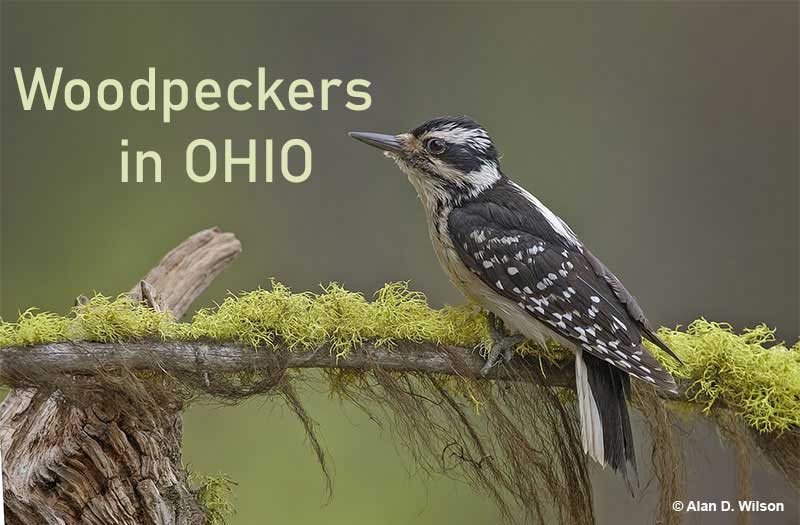
Are there woodpeckers in Ohio? There sure are, and in most parts of the state, these beautiful birds are common!
Go to a local park and you’ll see and hear a Northern Flicker or two. Watch birds in just about any backyard, and a handsome Downy Woodpecker will pay a visit!
In Ohio, there are seven common woodpecker species. We bet you’ve seen a lot of woodpeckers in Ohio, but could you identify all of them?
Most Common Woodpeckers in Ohio
Based on eBird data, our list shows the seven most common woodpeckers of Ohio.
Whether you see them drumming on tree trunks, foraging on the ground, or enjoying a meal at your backyard feeders, woodpeckers are a truly joyous sight.
To learn more about these fun birds, we have included information about their behavior and key field marks to identify them.
Red-bellied Woodpecker
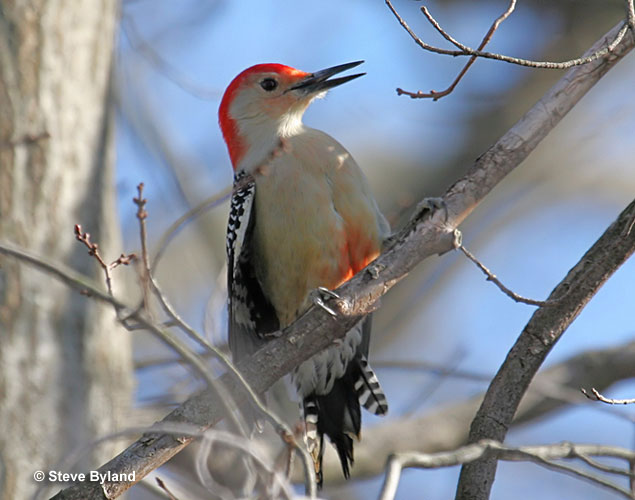
Scientific name: Melanerpes carolinus
Length: 9.25 inches
Wingspan: 16 inches
Red-bellied Woodpeckers are bold birds with long, dark, chisel-like beaks, and backs with zebra-like barring.
Despite their name, it’s really hard to see the red on this bird’s underparts! Although they do have a bit of red or reddish-orange, it’s hidden on the lower part of their belly. The rest of their underparts and faces are a pale gray-buff color, and they have a bit of orange above their beak.
Male Red-bellied Woodpeckers have bright red caps, females only have red on their nape and young birds only show a bit of orange on the back of their head.
We see pairs of this common woodpecker species in all sorts of woodlands. As long as big trees are present, they can even live in urban areas, and often come to feeders.
Red-bellied Woodpeckers are year-round residents in Ohio.
Key identifications:
- In most of their range, Red-bellied Woodpeckers are the only woodpecker species that has zebra-like, black and white barring on their back and wings.
- Red-bellied Woodpeckers have a pale face and red on their nape.
- This species has plain buff-gray underparts.
Downy Woodpecker

Scientific name: Dryobates pubescens
Length: 6.75 inches
Wingspan: 12 inches
Downy Woodpeckers are small, cute woodpeckers with black and white plumage. They have bold, black and white markings on their heads, black and white wings, and white bellies.
This woodpecker is slightly bigger than a sparrow, and the smallest woodpecker species found in Ohio.
Male Downy Woodpeckers have a small red patch on the back part of their head. Females look like males but lack this red patch, and young birds have red on the top of their heads.
This small bird is common in all sorts of wooded habitats. They like to use their small beaks to peck into twigs and often forage with flocks of chickadees and other birds.
This beautiful little woodpecker is also a regular visitor to backyards and can live in urban areas with lots of trees. They also come to bird feeders, especially ones that offer suet, sunflower seeds, and peanuts. Surprisingly, Downy Woodpeckers even eat berries!
Key identifications:
- Downy Woodpeckers are smaller than all other woodpeckers in North America. They are nearly as small as a House Sparrow.
- This species has a short and stubby beak (for a woodpecker).
- Downy Woodpeckers have small dark markings on their white outer tail feathers.
Northern Flicker

Scientific name: Colaptes auratus
Length: 12.5 inches
Wingspan: 20 inches
Northern Flickers are big, unique, gray and tan woodpeckers with bold white rumps. They have buff underparts with black spotting and a bold black patch on their chest, and fine black barring on their back and wings.
This species has some differences depending on where they live. In Ohio, Northern Flickers have a small red spot on their nape and a black mustache mark (males). Eastern birds also have bright yellow underwings. These subspecies are known as Yellow-shafted or Red-shafted Flickers.
Northern Flickers love parks, fields, and other semi-open habitats. In such places, we often see them in bounding flight, or perched on the ground as they forage for ants. These noisy birds also make laughing calls and “wicka-wicka” vocalizations.
This bird forages on the ground, ants make up a large part of the diet, but during winter, they mainly eat fruit and seeds. They like suet feeders; the fatty contents give them an extra boost, but they do not come to feeders too often.
Key identifications:
- In most of their range, Northern Flickers are the only woodpecker with gray and brown plumage.
- This species has a gray crown and fine black barring on its tan-colored back.
- Northern Flickers also have a black chest patch and black spotting on their underparts.
Hairy Woodpecker
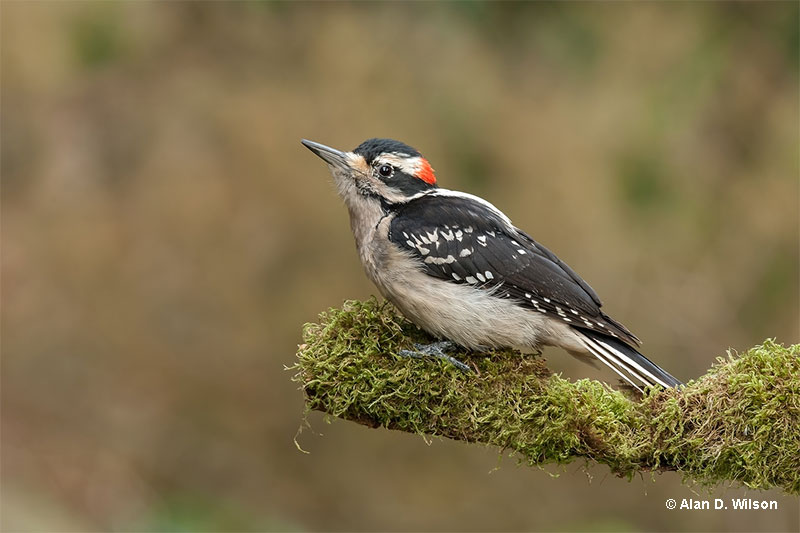
Scientific name: Dryobates villosus
Length: 9.25 inches
Wingspan: 15 inches
Hairy Woodpeckers are medium-sized, black and white woodpeckers with a fairly long and sharp beak. They have a bold black and white pattern on their head, white back, black rump, and black and white wings.
If that description sounds like a Downy Woodpecker, it’s true, these two species look almost exactly the same! However, in addition to details mentioned below, they also differ in another main way.
Read more: Downy vs Hairy Woodpecker
While Downy Woodpeckers like second-growth and plants with thin stems, Hairy Woodpeckers only live in places with big, mature trees. We mostly find these woodpeckers in forests, but they can also occur in parks and suburban areas that have lots of big trees.
Hairy Woodpeckers can also visit feeders, especially for suet. In Ohio, Hairy Woodpeckers are not as common as Downy Woodpeckers, but they still live here year-round!
Key identifications:
- Hairy Woodpeckers have noticeably longer beaks than Downy Woodpeckers, and are also larger birds.
- The Hairy Woodpecker has a big white patch on its back.
- This species has plain white underparts and clean white outer tail feathers.
Pileated Woodpecker
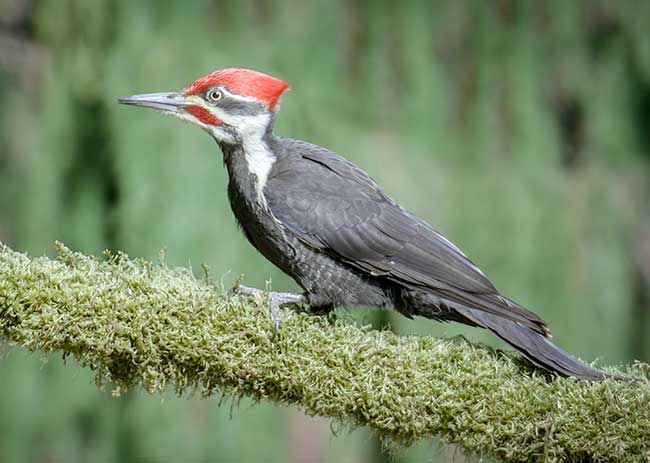
Scientific name: Dryocopus pileatus
Length: 16.5 inches
Wingspan: 29 inches
Pileated Woodpeckers are really big woodpeckers. So big in fact, that if the Ivory-billed Woodpecker is actually extinct, it would make the Pileated Woodpecker the biggest woodpecker in North America.
Related: Extinct birds – what happened to them?
These unmistakable woodpeckers are mostly black with a thick white line on each side of their neck, and a white throat. They also have a red crest and a long, grayish beak. Males have a small red mustache, while females have a black line that extends from their beaks to their necks.
This fantastic woodpecker lives in forests and woodlands with lots of big, mature trees. For that reason, we don’t usually see them in urban areas.
However, they can visit feeders at houses next to or within the forest!
Pileated Woodpeckers like a wide array of food. They can even eat some fruits and berries, such as Elderberries, grapes, Dogwood, apples, and many other options.
Key identifications:
- In most places, Pileated Woodpeckers are the only big black and white woodpecker with a red crest.
- This species has a small white patch near the tip of each upperwing. They also have white wing linings.
- Pileated Woodpeckers have a lot of white on their face and a completely black back.
Red-headed Woodpecker

Scientific name: Melanerpes erythrocephalus
Length: 9.25 inches
Wingspan: 17 inches
Red-headed Woodpeckers are beautiful, medium-sized woodpeckers with a completely deep red head. Adults of both sexes look alike and have a sharp gray bill, and bright white underparts.
Their upperparts are glossy black with a snow-white rump, and big white patches on their wings. Juvenile Red-headed Woodpeckers have a similar plumage pattern but have a gray-brown head, and some dark markings on their wings and underparts.
This striking bird prefers semi-open habitats with mature oaks, snags, and other big trees. We see them in open areas, at the edges of rivers and other wetlands, and other places with similar-looking habitat.
Red-headed Woodpeckers are a pretty common species of woodpeckers in Ohio and in eastern United States in general.
They often drum on dead trees, but they also catch insects in flight. With that in mind, we often see them sallying into the air from tall snags next to open areas.
Key identifications:
- Red-headed Woodpeckers are the only woodpecker species in eastern North America with an entirely red head.
- This species has a unique wing pattern with big white patches on the base of each wing.
- The Red-headed Woodpecker has a black tail and an extensive white rump.
Yellow-bellied Sapsucker
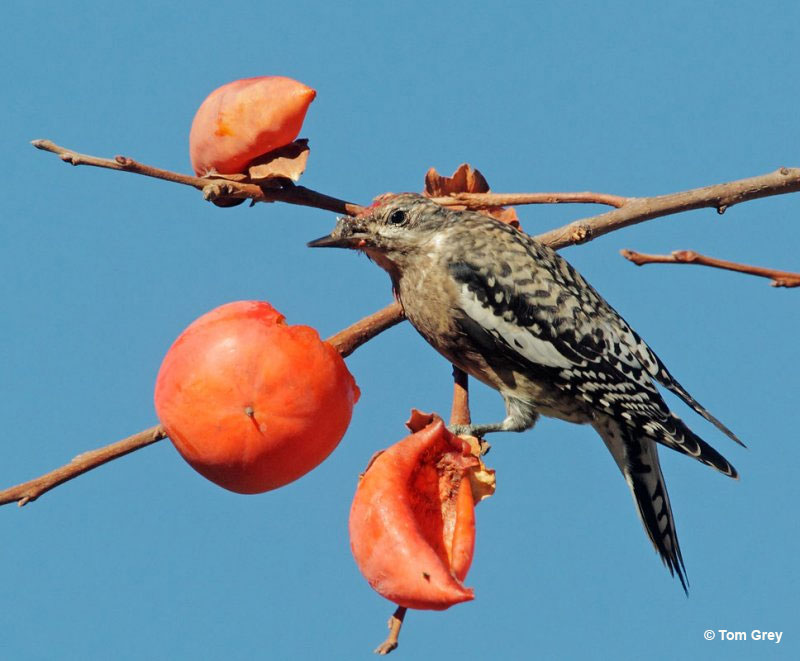
Scientific name: Sphyrapicus varius
Length: 8.5 inches
Wingspan: 16 inches
Yellow-bellied Sapsuckers are pretty, medium-sized woodpeckers that look drastically different from other woodpecker species. As the name hints, they have some yellow on their underside, but their plumage looks speckled, with some white stripes on their wings and tail.
Males also have a red throat bordered with black, while females have a white throat. Juvenile Yellow-bellied Sapsuckers look like adults but are more dingy gray-brown, and lack red on their heads.
Yellow-bellied Sapsuckers are commonly seen in Ohio during winter. They do not usually spend the breeding season in Ohio, but some birds can be spotted during the summer months too!
These birds like to peck rows of small holes in deciduous trees. It drinks the sap that comes out, as well as insects attracted to the sap.
Key identifications:
- Yellow-bellied Sapsuckers are the only woodpeckers in most of their range with white shoulders.
- This species has a black chest and uneven barring on its sides.
- The Yellow-bellied Sapsucker has lots of uneven, mottled black and white barring on its back.
Woodpeckers in Ohio – Frequently Asked Questions
Are woodpeckers common in Ohio?
Yes, woodpeckers are common in Ohio. Seven species are commonly seen in most parts of the state.
Where do woodpeckers usually live?
Woodpeckers usually live in forest, woodlands, and park-like habitats with big trees.
Do woodpeckers stay in Ohio in the winter?
Woodpeckers do stay in Ohio during winter; the most common residents are Downy and Hairy Woodpeckers and Red-bellied Woodpeckers.
What is a small black and white woodpecker in Ohio?
A small black and white woodpecker in Ohio is the Downy Woodpecker. This species is common throughout the Buckeye state.
What is the big red-headed woodpecker in Ohio?
The big red-headed woodpecker in Ohio is probably a Pileated Woodpecker. This woodpecker is about the same size as a crow. Smaller, robin-sized woodpeckers in Ohio with red on their heads include the Red-bellied Woodpecker and the Red-headed Woodpecker.
Read next – Common Birds in Ohio | Hawks in Ohio | Owls in Ohio | Ducks in Ohio | Hummingbirds in Ohio

